Email: ev.barchugova@markhi.ru
Revised 24 January 2022
Accepted 25 November 2022
Available Online 10 January 2023
- DOI
- https://doi.org/10.55060/s.atssh.221230.050
- Keywords
- Artistic language of street art
City promotional practices
Performances
Installations
Multimedia technologies - Abstract
This article is devoted to the role of contemporary art. Having changed the forms of artistic expression and the principles of interaction with the viewer, it has embarked on a path of rapprochement with it. The loss of the old ideological pillars allows art to broadcast the changes taking place in society in a new way, and it provides a person with the opportunity to gain a new view of reality. A wide range of artistic interpretations of the urban space is considered, which is presented not only as an arena, but also as a participant in an artistic experiment designed for the active interpretive perception of the audience. Examples of action art are given: performances, actions, installations, the experience of including ‘big’ sculpture in the urban context and possibilities of projection art based on digital and multimedia technologies.
- Copyright
- © 2022 The Authors. Published by Athena International Publishing B.V.
- Open Access
- This is an open access article distributed under the CC BY-NC 4.0 license (https://creativecommons.org/licenses/by-nc/4.0/).
1. INTRODUCTION
Art has always helped to reveal and to manifest the spiritual world of humans. In the context of the new digital paradigm, the significance of the experience of creating urban artistic practices or participating in them increases dramatically, because it immerses a city dweller, who is far from the sphere of art, into the atmosphere of creativity, opens up a possibility of self-realization, sharpens awareness of the integrity of the picture of being, and allows to solve problems inaccessible to computer programs. In her lectures, T.V. Chernigovskaya often cites the words by Yu.M. Lotman that art does not reflect life, but creates and generates the world around us.
However, a part of the cultural establishment believes that real art is over, it has ceased to exist. I.A. Antonova, a well-known cultural figure, former director and president of the Pushkin Museum of Fine Arts, perceived and described the transformation of the art sphere as a crisis, the death of the art that had been developing since the 14th–16th century including “that one started by the Renaissance. We are witnessing a really big crisis in the art system” [1]. I.A. Antonova saw the main reason in the fact that “the principle of aesthetics, spirit and the principle of the ideal, that is, art as a high example, to which one must strive, being aware of all one's human imperfection, is being destroyed” [1]. She assessed what is now presented at exhibitions and biennials as “a gesture, a statement, but not art” [1].
V.V. Bychkov, historian of aesthetics, Doctor of Philosophy, takes a more restrained position on this matter. He focuses on the historical course of events, when, with the beginning of the Italian Renaissance, there was a separation of the emerging science and individual areas of art from the Church; and their main purpose was to express the non-utilitarian high ideals of the epoch. According to V.V. Bychkov, the essence of the historical European understanding of art, in a its mimetic function, is the implementation of the principle of imitation of the existing reality “in artistic images ... that allow one to penetrate into the essential depths of the displayed object, inaccessible to knowledge and comprehension by any other means .... Depending on what exact reality was the subject of mimesis (reflection, image) of art and how the functions of the artist and the essence of beauty were understood in this or that system, the art developed certain methods and ways of expression” ([2], pp. 35).
2. ART OF THE INFORMATION SOCIETY
In the 20th century, when the foundations of a new technological society were being laid down, there was a change of goals in artistic creativity. Both philosophers (such as S.N. Bulgakov and V.S. Soloviov), and persons of Russian avant-garde put forward the idea of the death of fine arts, bringing art into life and organizing it according to other, more actual principles. “Art came into life and dissolved in it almost without a trace” ([2], pp. 37). The forms in which eternal truths and human experience were presented remain testimonies and signs of their time. The ideals of the past had not lost their significance, but the ways of expressing universal ideals have changed. The art of each era speaks to a person in a language understandable to a contemporary.
Nowadays, the sphere of art is not as elite as before, it has become more accessible, but this does not mean that art has ceased to talk about the main thing, about the beautiful, and has descended to the everyday life. The analysis of art exhibitions, practices and actions shows the opposite. As an example of the continuity of the best artistic traditions, one can regard the exhibition of Bill Viola that took place from March to May 2021 at the Pushkin Museum of Fine Arts. Viola is a recognized master of video art, who has been involved in video art for over 40 years. The artist's works are dedicated to the eternal issues of life, death, birth, fate. Man lives in his stories in the interaction with the elements of water, fire, earth, wind. It is almost impossible to convey his works in static images, since each of them is a dynamic story, lasting from 5–7 to 30 minutes (Fig. 1).
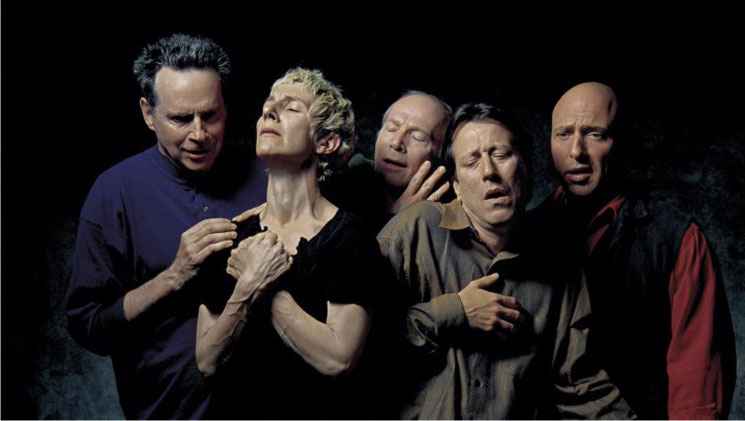
One cannot but agree with the opinion of V.V. Bychkov, that by today the role of art has been transformed, the methods of dealing with the audience have expanded, became dynamic, in many cases promotional. In addition to their main function and talking about the eternal, “works of art performed and continue to perform other, non-aesthetic, but sometimes very significant social and utilitarian functions – political, ideological, sacred, religious, confessional, moral and ethical, compensatory, entertaining, etc. …which at certain historical stages and in certain social situations were perceived as more significant than the aesthetic ones, and, sometimes, as the only functions of art” ([2], pp. 41). Under the conditions of transitional times, when it comes to the future structure of the world, art speaks with a person about the opening prospects with all means available to it, warning about dangers and erroneous rational-utilitarian vision of the world in which humanity has been living for the last five hundred years.
Among the theoretical heritage of the 20th century, works by Umberto Eco stand out and give a forecast which is more and more confirmed nowadays. Thus, in the treatise ‘Open Work’ (Opera Aperta, 1962), Eco states that art begins its own searches, multiplying the variety of activities and initiating a dialogue between artist and public. Transformation of the position of the perceiver gave not only a new type of public attitude, but other forms of art as well [3].
Exploring the relationships of repetition and innovation in history and in contemporary art, Eco draws attention to the following fact: “Traditional aesthetics did not strive for innovation at any cost: on the contrary, it often took solid copies of eternal pattern for ‘beauty’” [4]. Today, a shift has happened in emphasis towards getting a certain aesthetic pleasure from an infinite number of interpretations, films and TV-series, literary sequels.
“In such new situation of unifying, standardizing models of society… the ‘enlightening’ model of culture associated with a strict hierarchy of cultural norms and values is being replaced with a ‘polycentric’ one, where no center claims to be exclusive and nothing has a special right to be a unique truth, and any hierarchical models ceased to be taken for adequate images of reality” ([5], pp. 60).
3. CONTEMPORARY ART PRACTICES IN THE URBAN ENVIRONMENT
Historically, architecture always served as a unifying basis for many types of art: painting, sculpture, various artistic practices. In the 20th century, those ties were broken. In Modernism, interesting studies and experiments were carried out with color, light, new methods for processing materials, but most of the architectural structures were ‘cleared’ of direct interaction with related types of artistic creativity. Today, the urban space is undergoing a new artistic rethinking, its streets and squares are being mastered by various creative teams.
Turning to specific examples of urban artistic practices, it is necessary to note the role of new screen-computer and interactive media. And it does not matter whether artists, sculptors themselves use electronic means of reproducing pictures, texts, projecting images, get with mechanical and other devices, or rely on the plasticity of their bodies, dance, etc. The abovementioned general trends of the time include dynamism, interactivity, incompleteness, and dialogism of contacts; they arise as a result of universal influence of the network technologies and characterize the vast majority of interactions.
3.1. Action Arts
In the first decades of the 21st century, performances, actions, installations, and performances-promenades, initially focused on spectator participation, became a noticeable part of urban artistic interactions. In such action-events, the city acts not only as a background, but as an active context, a participant in the process, with which performers and spectators are related.
The Austrian choreographer Willy Dorner uses dance-sculptural and choreographic visual means in his urban performances. In the 1980s, he performed as a dancer in various troupes in Austria and America, and as early as then started to work as a choreographer. In 2012, the master came to Moscow and presented his performance “Bodies in Urban Spaces” [6]. A series of similar performances were repeated in numerous cities of the world. The basis of the performance was a route along the city streets, along which a group of performers in bright tracksuits moves created as if spontaneous plastic compositions in space. The purpose of the performance was to highlight iconic and historical places, and to draw attention to the usual objects of the urban environment. The stories evoked vivid impressions and emotions. Familiar places in Moscow appeared before the audience in a festive and unexpected way, connecting the finds of the choreographer and the urban context (Fig. 2).
Such procedural actions meet the claims of art for unusual interactions with urban space. The public is actively involved in the game; it becomes a participant in the event. The master gives the auditorium a new experience of a fragment of urban space.
3.2. Installation
“The transition to the process art went through the installation, which became the leading form of creativity in the art of the 1970s – 1980s” [7]. In the 21st century, the genre of installation has been actively developing, ‘exchanging’ means and methods of work with the promotional art forms. On the whole, in the 21st century, installations got larger and more diverse in terms of the artistic means. Artists vary the scale of installations from a small object, comparable to a human hand, to the size of a large building. They use and combine objects of the everyday environment of a person, lighting effects, and complex computer technologies (for example, mapping).
An intermediate position between installation and performance is occupied by the work of Canadian artists Caitlind r.c. Brown & Wayne Garrett “Cloud” (Fig. 3). In different versions, it was shown in many cities around the world. This is an interactive installation of 6,000 light bulbs grouped in separate chains. The viewer can create different versions of the composition by turning the lights on and off. The interaction of people is aimed at both playing with light and interacting with each other.
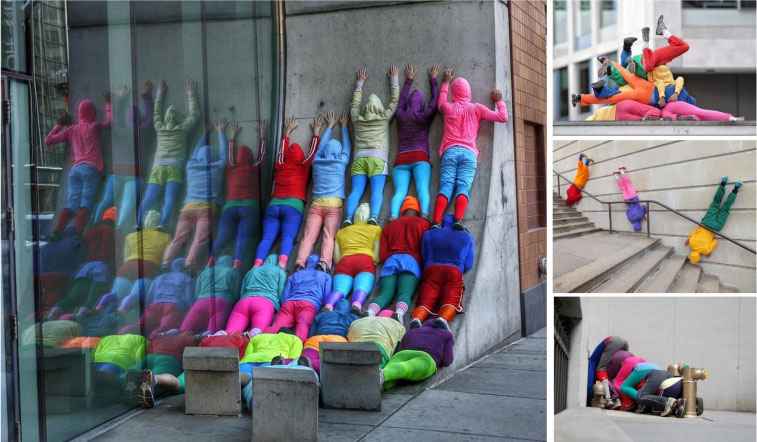
Willie Dorner performance, “Bodies in Urban Spaces”. Photos by the authors.
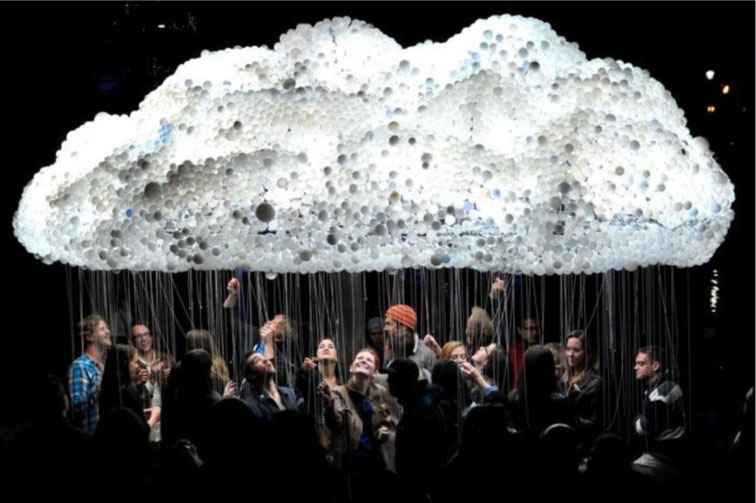
3.3. Mapping
The widespread technology of projecting any images onto the exterior and interior surfaces of buildings and structures is also based on lighting effects. Mapping can be combined with the real urban environment based on techniques ranging from the synthesis of arts to synthetic activities with an emphasis on its various components.
Image projection is widely used in theaters, clubs, concert halls, and open public spaces in cities. Such images can move with or without the actors, representing a well-thought-out theatrical scenario. In the article “Video Mapping from Presentation to Architecture” [8], levels and methods of interaction of such technology with the urban architectural environment are studied in sufficient detail. It is noteworthy, that it is usually a large-scale static or dynamic visual action that requires expensive equipment, certain software, and a solid artistic script. Light installations are not only very spectacular, but also informative. No wonder, that nowadays our cities are, in fact, light installations in the dark. “New genres of art contribute to the mass character and expansion of the artistic sphere. Authors reconsider their attitude to everyday life. They include it into the construction of a common artistic picture of the world. For both authors and consumers, there is a convergence of levels of everyday and artistic thinking.” [8]
3.4. City Sculpture
Art reacts faster than architecture to general changes in the conditions of the development of society. Thus, ‘large’ urban sculpture became a separate artistic phenomenon of modern urbanized spaces. The analysis shows that the phenomenon of a knocked down or large-scale size of such compositions is characteristic for modern urban space. Screen culture, where the concept of scale is practically absent, ‘goes out’ to the city and influences at all forms of art. The development of animation also contributes to the spread of such type of creativity. Popular characters of various sizes appear on the streets of cities. The satiety of the modern city dweller with information and a variety of contacts forces artists to exaggerate forms of urban sculpture.
A beginning of this type of art was laid by Claes Oldenburg in the 1960s. He started a tradition of pop art to play with everyday objects in the form of three-dimensional compositions and sculptures, many times exceeding their real prototypes. This creative line is being improved and updated in works of artists today. The possibilities of using a variety of materials and techniques for displaying the aesthetic characteristics of an object are being worked out. Most often, bright colors are used, as well as the style of minimalism. Reinforced plastic is the most common material.
Over time, the initial provocative message of Oldenburg ceased to be read by the public, simply because this type of art was accepted and widespread. But now the humor inherent in all the works by the master remains in demand. The element of absurdity typical for large sculpture makes one to pay attention to the general meaning of the performance, to think about the problems of existence of the world and man.
The general precariousness and fragility of the human-made environment is a major connotation in the “Support” installation, which artist Lorenzo Quinn set on the Grand Canal in Venice in 2017 (Fig. 4). The similar theme was manifested in his installation “The Tree of Life” in front of the St. Martin's Church in Birmingham. The master often refers to the theme of the hand: giving, protecting, supporting.
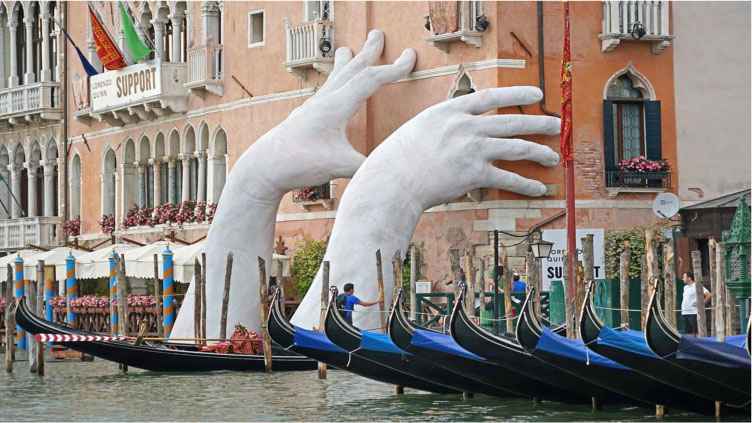
Lorenzo Quinn, “Support”. Source: http://www.cheaptrip.ru/wp-content/uploads/2018/04/35086284560_f8751b3627_b.jpg
In 2015, a multi-meter sculpture of a blue bear (artist: Lawrence Argent) appeared near the Convention Center in Denver (U.S.). The sculpture emphasizes the importance of the events taking place in the building and was called “I see what you mean”. Recently, a kind of answer to it was set in Moscow, in Tsvetnoy Boulevard, personifying the name of the nearby restaurant, which it is looking at. The 2016 “Valenok” installation (also related to the name of the restaurant) became an attraction of Tsvetnoy Boulevard. It was an art object by the St. Petersburg artist Valeria Loshak named “Russian Size”. The installation ‘changes clothes’ according to the seasons. This is the third “valenok” (traditional Russian winter felt boot) by the artist. The first two stand in Vyborg and Priozersk. According to the author, the purpose of the installation is to draw attention to national culture and traditions. In Moscow, “Valenok” in Tsvetnoy became a place popular among young people for meetings and selfies.
3.5. Graffiti
Speaking of urban art, it is impossible to miss graffiti. Modern graffiti easily transcends artistic design of building façades and, like installations, it often becomes a kind of incorporating a QR code into an image. The second part of the graffiti, seen by the user through a mobile phone, can be a static or animated fragment. In general, modern graffiti differs from its predecessors. In large cities, the legal part of graffiti stands out, which for the most part lost its protest character and became a part of the official types of decoration of building façades. Most often, such graffiti appears on the façades of public buildings.
There is an example of the building of the Trade Center ‘Atrium’ near the Kursk Railway Station in Moscow (Fig. 5). Graffiti on its façades was created by artists from different countries (U.S., Great Britain, Spain, Venezuela, France, Russia), high professionals in their field.
Graffiti appears on both office and residential buildings. The main reason for the legalization and popularity of modern graffiti is an attempt to remove the monotony of formal design and create a vivid, memorable image of constructions. Such design of buildings confirms some return to the abovementioned unification of arts based on architecture.
The social content, previously constituted the semantic part of graffiti messages, is gradually transforming. The main part of the large murals entered the legalized methods of decorative design of façades. However, those small graffiti located close to the level of the viewer's eyes retain a sharper social meaning. This is a small picture of a shot from the film directed by A. Tarkovsky “Nostalgia”, created by the artist ZOOM near the Tarkovsky's house in Shchipok Street in Moscow. A portrait of M. Zakharov, created by Alexei Kokorin, an artist of the Lenkom Theater, in Nastasinsky Lane on the eve of the director's funeral, also makes a great impression. Graffiti is a relatively short-lived art and the works which the city wants to preserve need to be maintained and refurbished.
3.6. Augmented Reality
One of the largest inclusions of artistic actions into urban space is the spreading forms of duplication of such space in a virtual environment: augmented reality (AR) applications. Such projects allow the user to navigate in the space of the city, and also pursue information, educational, and organizational aims.
But, most of all, their significance is manifested in the very fact of their existence: we get used to the fact that everywhere, at any point of urban space where we get, we are accompanied by another layer of activity: a virtual one. It becomes a necessary addition to reality, on which we rely, drawing information from there, trusting the assessments that are expressed there.

Filippo Pantone, graffiti on the façade of the Trade Center ‘Atrium’ near Kursk Railway Station in Moscow. Source: https://yandex.ru/images/search?cbird=5&rpt=imageview&redircnt=1642867359.1&url=https%3A%2F%2Favatars.mds.yandex.net%2Fget-images-cbir%2F2231818%2FYKseX2CvjhjKvZkJRadeRw8751%2Forig&cbir_id=2231818%2FYKseX2CvjhjKvZkJRadeRw8751
One of the first cities in the world where the “Augmented City” Project has been implemented was Bari in Italy. In a mobile application for a phone or tablet, the user can see an analogue of a three-dimensional image of the place where he is. According to specialists, the application includes an area of 117 km2 and information about more than 4,500 objects of various purposes (monuments of architecture and art, signs, routes, recommendations and information).
Subsequently, the application was also considered as an opportunity to raise investments for the restoration of architectural and art monuments1. The augmented reality technology is to be used for such purposes for the first time. One of the investment objects was the Madonellas, small images or sculptures of Madonna, placed at the crossroads and on the corners of houses in Bari (Fig. 6). The townspeople considered them as protection of the doors of their house, their street or alley. Until recently, all the responsibility for preservation of those pieces of art fell only on the shoulders of local residents. Nowadays, the information collected on each artifact and a detailed map of the location of Madonellas can attract attention from tourists or internet users. Thus, the organizers hope to intensify fund raising for their restoration and/or maintenance.
Augmented reality projects can contain special labels that rank the city environment depending on the user's priorities, reviews of visits to cafes and restaurants, their menus, show parking lots and availability there. The developers hope that soon users will be able to adjust applications for themselves by entering personal information about memorable places and objects into them through photos and video clips.
4. CONCLUSION
In our technocratic age, to have the freedom to manage one's life, time, and activity means that a person needs to develop ‘non-machine’ ways of thinking, expand his participation in creative endeavors and practices, and improve the spiritual aspects of his or her existence. This testifies to the particular relevance of contemporary art, including street art, interacting with a person in a specific language of images, developing intuition, operating with abstract sensual images and symbols. The article “Technological Paradigm and the Social Life of the Metropolis (on the Example of Moscow)” convincingly shows the role of modern urban space as a neutral, average environment for everyone, representing a possibility for individual manifestation [9].
Today, art, as well as society, is in a transitional state of searching for forms and methods of existence. By experimenting and acquiring new artistic practices, art is transformed along with society, participating in the refinement and correction of its goals and values.
Urban art objects adapt a person to changes, teach new types of interactions, include reflection, joy or sadness, support or protest. The digital form of artistic actions is becoming a familiar component of many works of contemporary art. Street art captures and reflects new aspects of our life, develops a specific artistic language based on manifestations of a two-level real/virtual reality.
Shaping of norms and rules of the new artistic language continues. Experiments indicate a need to regulate the use of technological innovations and effects that can cause a destructive effect on the viewer. Modern urban art requires additional studies of contacts and relationships with a person and the context of the environment, analysis of messages and ideas dictated by time.
There are enough works devoted to new phenomena of modern art practice, fixing individual forms of art. Unlike many studies that describe a particular direction, the authors of this article try to trace the general direction, the specifics of contemporary street art, to highlight those works whose purpose is to humanize the environment of contemporary life.
Digital technologies become a necessary vital component of daily urban activity. Actions and other forms of contemporary art, which we meet along the way, contribute to the development of value priorities and life orientations for most of the population.
The essence of this article is to correlate theoretical assessments of what is happening from the point of view of philosophers, art historians, and other specialists working in the field of culture, with specific artifacts that take place in the urban environment, in tracing the impact of digitalization on all types of artistic interactions, both with the use of technology and without it.
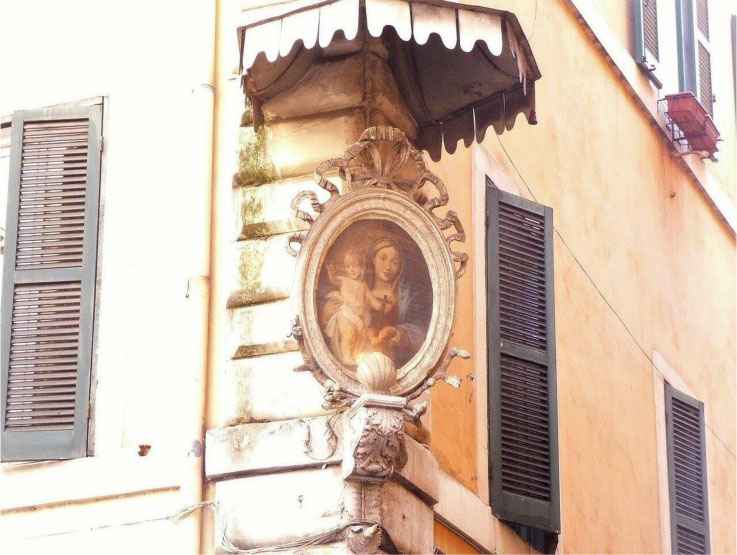
AUTHORS' CONTRIBUTION
Elena Barchugova: is responsible for experimental street art practices, examines them as a consequence of artistic reinterpretation of urban space, actualizes the emergence of new techniques of the artist's dialogue with the viewer, expanding the sphere of artistic and generating mass procedural art. She provides common features and differences, classifies modern artistic practices in the urban environment: performances, actions, installations, performances-promenades, initially focused on audience participation, provides common features and differences, and examines screen-computer and interactive tools in the practice of creative teams working on the streets of the city, as well as the duplication of urban space in a virtual environment – augmented reality (AR).
Natalia Rochegova: analyzed, summarized and generalized ideas of Russian and foreign authors on the research problem. The theoretical foundations of the philosophy of art of the information society, the transformation of its role in the general context of culture, the activation of the artist's dialogue with the viewer are given. The characteristic properties of art-streets, such as dynamism, interactivity, incompleteness and dialogism of contacts are presented as a consequence of the general influence of network technologies. The author summarized the results of the research and offered possible areas of future research.
ACKNOWLEDGMENTS
This study is based on research supported by the Program of Fundamental Research of the Russian Academy of Architecture and Construction Sciences and of the Ministry of Construction, Housing and Utilities of the Russian Federation, 2022.
Footnotes
On 15 July 2020, the informational portal ‘Vedomosti’ declared that the “Lanit Tercom”, one of the biggest Russian IT companies with a branch in Bari, together with the Italian “Augmented City” Project, placed to gather investments for the restoration of 240 Italian churches and objects of cultural heritage. https://www.vedomosti.ru/press_releases/2020/07/15/lanit-terkom-i-augmentedcity-pomogut-vosstanovit-madonelli-starogo-bari-s-pomoschyu-ar
References
Cite This Article

TY - CONF AU - Elena Barchugova AU - Natalia Rochegova PY - 2023 DA - 2023/01/10 TI - Contemporary Art and the City BT - Proceedings of the 4th International Conference on Architecture: Heritage, Traditions and Innovations (AHTI 2022) PB - Athena Publishing SP - 365 EP - 373 SN - 2949-8937 UR - https://doi.org/10.55060/s.atssh.221230.050 DO - https://doi.org/10.55060/s.atssh.221230.050 ID - Barchugova2023 ER -









